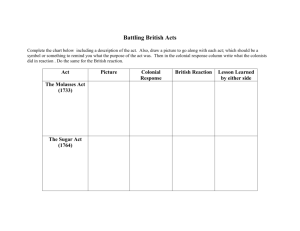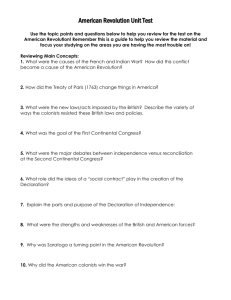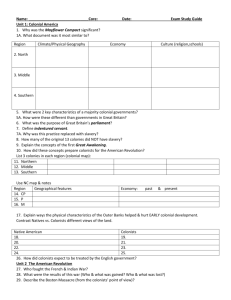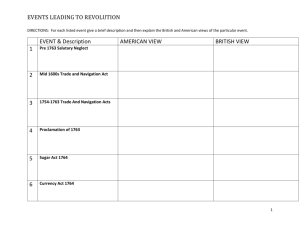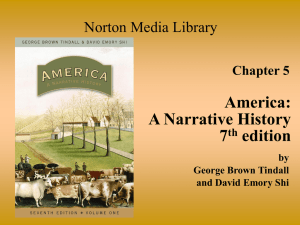Reading Guide -- Chapter 5
advertisement
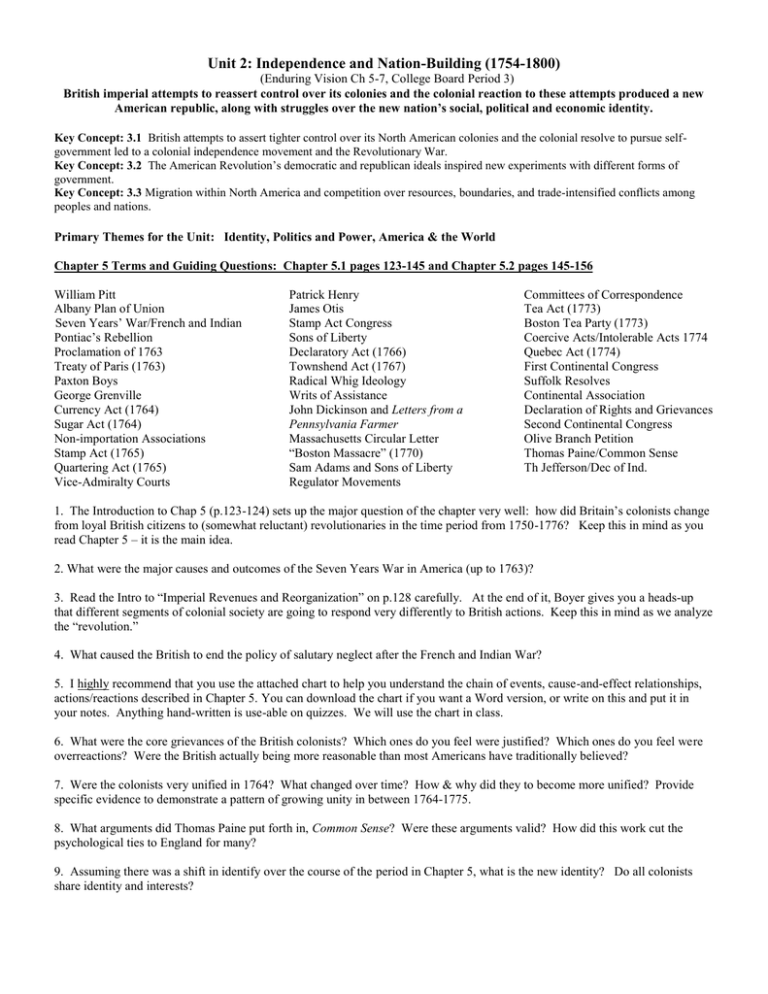
Unit 2: Independence and Nation-Building (1754-1800) (Enduring Vision Ch 5-7, College Board Period 3) British imperial attempts to reassert control over its colonies and the colonial reaction to these attempts produced a new American republic, along with struggles over the new nation’s social, political and economic identity. Key Concept: 3.1 British attempts to assert tighter control over its North American colonies and the colonial resolve to pursue selfgovernment led to a colonial independence movement and the Revolutionary War. Key Concept: 3.2 The American Revolution’s democratic and republican ideals inspired new experiments with different forms of government. Key Concept: 3.3 Migration within North America and competition over resources, boundaries, and trade-intensified conflicts among peoples and nations. Primary Themes for the Unit: Identity, Politics and Power, America & the World Chapter 5 Terms and Guiding Questions: Chapter 5.1 pages 123-145 and Chapter 5.2 pages 145-156 William Pitt Albany Plan of Union Seven Years’ War/French and Indian Pontiac’s Rebellion Proclamation of 1763 Treaty of Paris (1763) Paxton Boys George Grenville Currency Act (1764) Sugar Act (1764) Non-importation Associations Stamp Act (1765) Quartering Act (1765) Vice-Admiralty Courts Patrick Henry James Otis Stamp Act Congress Sons of Liberty Declaratory Act (1766) Townshend Act (1767) Radical Whig Ideology Writs of Assistance John Dickinson and Letters from a Pennsylvania Farmer Massachusetts Circular Letter “Boston Massacre” (1770) Sam Adams and Sons of Liberty Regulator Movements Committees of Correspondence Tea Act (1773) Boston Tea Party (1773) Coercive Acts/Intolerable Acts 1774 Quebec Act (1774) First Continental Congress Suffolk Resolves Continental Association Declaration of Rights and Grievances Second Continental Congress Olive Branch Petition Thomas Paine/Common Sense Th Jefferson/Dec of Ind. 1. The Introduction to Chap 5 (p.123-124) sets up the major question of the chapter very well: how did Britain’s colonists change from loyal British citizens to (somewhat reluctant) revolutionaries in the time period from 1750-1776? Keep this in mind as you read Chapter 5 – it is the main idea. 2. What were the major causes and outcomes of the Seven Years War in America (up to 1763)? 3. Read the Intro to “Imperial Revenues and Reorganization” on p.128 carefully. At the end of it, Boyer gives you a heads-up that different segments of colonial society are going to respond very differently to British actions. Keep this in mind as we analyze the “revolution.” 4. What caused the British to end the policy of salutary neglect after the French and Indian War? 5. I highly recommend that you use the attached chart to help you understand the chain of events, cause-and-effect relationships, actions/reactions described in Chapter 5. You can download the chart if you want a Word version, or write on this and put it in your notes. Anything hand-written is use-able on quizzes. We will use the chart in class. 6. What were the core grievances of the British colonists? Which ones do you feel were justified? Which ones do you feel were overreactions? Were the British actually being more reasonable than most Americans have traditionally believed? 7. Were the colonists very unified in 1764? What changed over time? How & why did they to become more unified? Provide specific evidence to demonstrate a pattern of growing unity in between 1764-1775. 8. What arguments did Thomas Paine put forth in, Common Sense? Were these arguments valid? How did this work cut the psychological ties to England for many? 9. Assuming there was a shift in identify over the course of the period in Chapter 5, what is the new identity? Do all colonists share identity and interests? THE ROAD TO REVOLUTION (1760-1775) *Be sure to include the Social, Political and Economic effects of the Events. Date 1760 Event Writs of Assistance -James Otis, Jr. 1763 Proclamation of 1763 -Pontiac’s Rebellion 1764 Sugar Act -External, Indirect Tax 1765 Stamp Act -Internal, Direct Tax -Sam Adams -Son’s of Liberty -Stamp Act Congress British (re)Action & Description of Policy* Colonial Response & Results* Date 1766 Event Declaratory Act 1765 Quartering Act 1767 Townshend Acts -External, Indirect Tax -John Hancock’s Liberty -“Spinning Bees” 1770 Boston Massacre -Crispus Attucks -Sam Adams -Sons of Liberty -Committees of correspondence British (re)Action & Description of Policy* Colonial Response & Results* Date 1773 Event Tea Act -British East India Company -Boston Tea Party 1774 Intolerable Acts -Coercive Acts -Quebec Act -First Continental Congress Suffolk Resolves 1775 Lexington & Concord -General Gage -Minute Men British (re)Action & Description of Policy* Colonial Response & Results* Date 1775 Event Second Continental Congress -Olive Branch Petition GW 1776 Declaration of Independence British (re)Action & Description of Policy* Colonial Response & Results* Chapter 6 Terms & Guiding Questions: Marquis de LaFayette Baron von Steuben Lexington & Concord Bunker Hill/Breed’s Hill Saratoga Ben Franklin Treaty of Alliance Yorktown Patriots (Whigs) Loyalists (Tories) Treaty of Paris (1783) Articles of Confederation John Locke Land Ordinance of 1785 Northwest Ordinance 1787 Northwest Territory Shays’s Rebellion Annapolis Convention Constitutional Convention James Madison Virginia Plan New Jersey Plan Connecticut or Great Compromise 3/5 Compromise Federalists and Anti-federalists The Federalist Papers Alexander Hamilton John Jay/Madison 1. It is said that even during the revolution, the colonists were split, more or less, into thirds: 1/3 Loyalists, 1/3 Patriots & 1/3 neutral. What were the reasons behind each of these perspectives? 2. What were the advantages and disadvantages of both the British and the Colonists during the Revolutionary War? 3. In the end, what forces combined to create victory for the United States of America in the war? 4. Considering the context of the times, in what ways were the Articles of Confederation the best possible form of government for the new nation, at the time? What were its crowning achievements? In what ways was it an insufficient form of government? 5. What were the key issues that delegates to the Constitutional Convention grappled with? How were they resolved at the time? 6. Explain both the Federalist arguments for ratifying the new U.S. Constitution and the anti-Federalist arguments for not ratifying the Constitution. 7. Why did Americans accept the Constitution with its strong national government and powerful executive after only a decade earlier violently revolting against similar British institutions? Why did the Anti-Federalists not violently oppose the new Constitution? Chapter 7 Terms & Guiding Questions: Judiciary Act of 1789 VA Declaration of Rights VA Statute of Religious Freedom Bill of Rights Washington’s Cabinet Report on the Public Credit Report on Manufactures Assumption Plan National Bank Strict and Loose Interpretation “Necessary and Proper” clause Tariffs French Revolution Proclamation of Neutrality Jay’s Treaty Whiskey Rebellion Pinckney’s Treaty Battle of Fallen Timbers “Mad” Anthony Wayne Treaty of Greenville Neutrality Proclamation Citizen Genet Washington’s Farewell Address John Adams XYZ Affair Quasi-war with France Alien and Sedition Acts VA & KY Resolutions Election of 1800 Republican motherhood 1. What were George Washington’s biggest challenges as the first President of the United States of America? How did he do? 2. Why did Hamilton move so rapidly to create large financial commitments by the federal government? Why did he think of a “reasonable” federal debt as something good and necessary for the national welfare? 3. Make sure you understand the emergence of the first two political parties: the Federalists and the Democratic-Republicans. How do these relate (or do they?) to the federalist/anti-federalist debates during ratification? 4. Whose vision for the nation was better: Hamilton’s British aligned foreign policy that focused on the wealthy and well-educated, as well as a strong manufacturing and banking underpinning to the economy, or Jefferson’s French-leaning foreign policy, his strong belief in the common man, and an agricultural-based society and economy. Which one ultimately prevailed? 5. Why were political parties viewed as so dangerous by the Founding Fathers? Why did parties come into being at all? 6. What were President John Adams’ biggest challenges? How did he do with them? Unit Questions (pay attention to these…) 1. Although the following words from the Declaration of Independence did not apply to women, African Americans (free or slave) and Native Americans, “…that all men are created free and equal,” how did these groups participate, either for or against the Revolutionary struggle? Did the revolution result in fundamental changes in their social or political status? 2. What did the American Revolution fundamentally change about American society and government? What was left unchanged? 3. Is the U.S. Constitution still a viable constitution for our present nation? Why or why not? What can we learn from the compromises that were required for its ratification? 4. Thinking back over the whole unit, when did revolution happen? When did independence happen? When did a unified American identity begin (if ever)?

